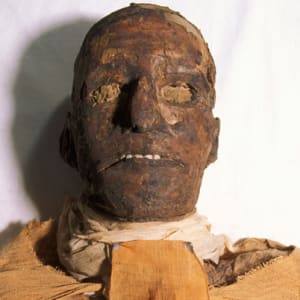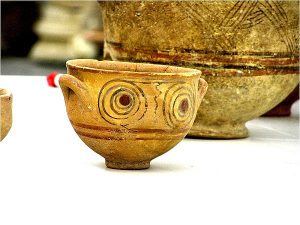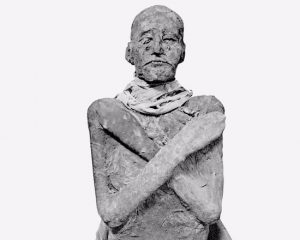The inspiration for this study aid came from Robert Sarmast. He produced a 60 min. documentary titled: Was Ramses III the Exodus Pharaoh? (These are not the only two spellings used for Rameses. Ramesses is also used.)
Moses Killed Rameses III
 This research page was created to support investigation into a number of intertwined mysteries.
This research page was created to support investigation into a number of intertwined mysteries.
Curiously enough, the authors of The Urantia Book did not identify which Pharaoh reigned during the Exodus. Perhaps, this information was withheld because we can figure that out for ourselves.
Neither the Old Testament account nor the Egyptian writings provide this information (directly). Could it be that both cultures did not want to talk about the specifics for different reasons?
The Urantia Book says that Moses and his followers killed Pharaoh and all the troops that chase after them. I am working with the theory that the Egyptian writers wanted to hide the fact that their leader and his troops were killed by a subjugated people, when they were trying to flee. What nation wants to carve that history into stone?
Perhaps the Jewish writers were more inclined to write in a way that maximized the mysterious power of their God and minimized future political problems with Egypt. With an understanding, presumably, of the difference between a battle and a war, I can see why writers of the Old Testament, generations later, might consider it overly provocative to say Moses defeated and killed Pharaoh. Wisdom favors trying to scare the Egyptians off with a story about how God saved his chosen people. In fact, this theme is still played on today.
As with Melchizedek, one has to wonder whether earlier writings had fuller and more accurate accounts, but then these were later altered without completely eliminating all the references to the facts of what occurred. (See 93:9.9)
That being said, here is the research I have put together so far. Please let me know about any additional information that you think should be included in this research topic.
From The Urantia Book:
96:3.4 Moses endeavored to negotiate diplomatically for the freedom of his fellow Semites. He and his brother entered into a compact with the king of Egypt whereby they were granted permission peaceably to leave the valley of the Nile for the Arabian Desert. They were to receive a modest payment of money and goods in token of their long service in Egypt. The Hebrews for their part entered into an agreement to maintain friendly relations with the Pharaohs and not to join in any alliance against Egypt. But the king later saw fit to repudiate this treaty, giving as his reason the excuse that his spies had discovered disloyalty among the Bedouin slaves. He claimed they sought freedom for the purpose of going into the desert to organize the nomads against Egypt.
96:3.5 But Moses was not discouraged; he bided his time, and in less than a year, when the Egyptian military forces were fully occupied in resisting the simultaneous onslaughts of a strong Libyan thrust from the south and a Greek naval invasion from the north, this intrepid organizer led his compatriots out of Egypt in a spectacular night flight. This dash for liberty was carefully planned and skillfully executed. And they were successful, notwithstanding that they were hotly pursued by Pharaoh and a small body of Egyptians, who all fell before the fugitives’ defense, yielding much booty, all of which was augmented by the loot of the advancing host of escaping slaves as they marched on toward their ancestral desert home.
Exodus:
13 17When Pharaoh let the people go, God did not lead them along the road through the land of the Philistines, though it was shorter. For God said, “If the people face war, they might change their minds and return to Egypt.” 18So God led the people around by the way of the wilderness toward the Red Sea. And the Israelites left the land of Egypt arrayed for battle.
14 Then the Lord said to Moses, 2 “Tell the Israelites to turn back and encamp near Pi Hahiroth, between Migdol and the sea. They are to encamp by the sea, directly opposite Baal Zephon. 3 Pharaoh will think, ‘The Israelites are wandering around the land in confusion, hemmed in by the desert.’ 4 And I will harden Pharaoh’s heart, and he will pursue them. But I will gain glory for myself through Pharaoh and all his army, and the Egyptians will know that I am the Lord.” So the Israelites did this.
15 19 For the horse of Pharaoh went in with his chariots and with his horsemen into the sea, and the Lord brought again the waters of the sea upon them; but the children of Israel went on dry land in the midst of the sea. 20 And Miriam the prophetess, the sister of Aaron, took a timbrel in her hand; and all the women went out after her with timbrels and with dances. 21 And Miriam answered them, Sing ye to the Lord, for he hath triumphed gloriously; the horse and his rider hath he thrown into the sea.
Rameses III:
The belief that Rameses III was Pharaoh when Moses led the Hebrews out of Egypt is a respectable minority position, bolstered significantly by Exodus 17 and 18. The Pharoah of the Exodus—Rameses III, by Prof. Gary A. Rendsburg, reviews the support for this perspective (in less than 900 words).
There are a number of mysteries related to the reign of Rameses III and his death.
From Wikipedia:
There is uncertainty regarding the exact dates of the reign of Ramesses III. This uncertainty affects the dating of the Late Bronze/Iron Age transition in the Levant. This transition is defined by the appearance of Mycenaean LH IIIC:1b (Philistine) pottery in the coastal plain of Palestine, generally assumed to correspond to the settlement of Sea People there at the 8th year of Ramesses III. Radiocarbon dates and other external evidence permit this transition to be as late as 1100 BC, compared to the conventional dating of c. 1179 BC. . . . Ramesses III claims that he incorporated the Sea Peoples as subject peoples and settled them in Southern Canaan, although there is no clear evidence to this effect; the pharaoh, unable to prevent their gradual arrival in Canaan, may have claimed that it was his idea to let them reside in this territory. Their presence in Canaan may have contributed to the formation of new states in this region such as Philistia after the collapse of the Egyptian Empire in Asia. Ramesses III was also compelled to fight invading Libyan tribesmen in two major campaigns in Egypt’s Western Delta in his Year 5 and Year 11 respectively.
At 41 meters long, [the Papyrus Harris I] is “the longest known papyrus from Egypt, with some 1,500 lines of text. . . . The hieratic text of the papyrus consists of a list of temple endowments and a brief summary of the entire reign of king Ramesses III of the Twentieth dynasty of Egypt. . . . He fought wars against the Peoples of the Sea and claims to have subdued them and made them subjects of Egypt.
One mystery The Urantia Book does seem to clear up has to do with the identity of the Sea People. The “Greek navel invasion” mentioned in 96:3.5, apparently, refers to the Sea People. From Wikipedia:
 The Sea Peoples remain unidentified in the eyes of most modern scholars, and hypotheses regarding the origin of the various groups are the source of much speculation. . . . The archaeological evidence from the southern coastal plain of ancient Palestine, termed Philistia in the Hebrew Bible, indicates a disruption of the Canaanite culture that existed during the Late Bronze Age and its replacement (with some integration) by a culture with a possibly foreign (mainly Aegean) origin. This includes distinct pottery, which at first belongs to the Mycenaean IIIC tradition (albeit of local manufacture) and gradually transforms into a uniquely Philistine pottery. Mazar says:
The Sea Peoples remain unidentified in the eyes of most modern scholars, and hypotheses regarding the origin of the various groups are the source of much speculation. . . . The archaeological evidence from the southern coastal plain of ancient Palestine, termed Philistia in the Hebrew Bible, indicates a disruption of the Canaanite culture that existed during the Late Bronze Age and its replacement (with some integration) by a culture with a possibly foreign (mainly Aegean) origin. This includes distinct pottery, which at first belongs to the Mycenaean IIIC tradition (albeit of local manufacture) and gradually transforms into a uniquely Philistine pottery. Mazar says:
… in Philistia, the producers of Mycenaean IIIC pottery must be identified as the Philistines. The logical conclusion, therefore, is that the Philistines were a group of Mycenaean Greeks who immigrated to the east … Within several decades … a new bichrome style, known as the “Philistine”, appeared in Philistia …
Although it was long believed that Ramesses III‘s body showed no obvious wounds, a recent examination of the mummy by a German forensic team, televised in the documentary Ramesses: Mummy King Mystery on the Science Channel in 2011, showed excessive bandages around the neck. A subsequent CT scan that was done in Egypt by Ashraf Selim and Sahar Saleem, professors of Radiology in Cairo University, revealed that beneath the bandages was a deep knife wound across the throat, deep enough to reach the vertebrae. . . . A subsequent study of the CT scan of the mummy of Ramesses III’s body by Sahar Saleem revealed that the left big toe was likely chopped by a heavy sharp object like an ax. There were no signs of bone healing so this injury must have happened shortly before death. The embalmers placed a prosthesis-like object made of linen in place of the amputated toe. The embalmers placed six amulets around both feet and ankles for magical healing of the wound for the life after. This additional injury of the foot supports the assassination of the Pharaoh, likely by the hands of multiple assailants using different weapons. Before this discovery it had been speculated that Ramesses III had been killed by means that would not have left a mark on the body. Among the conspirators were practitioners of magic, who might well have used poison.
See also the Wikipedia page: Battle of the Delta, which discusses Rameses III’s battle with the Sea Peoples.
See BBC article about the 2011 discovery of the fate of Rameses III.
See Mummy King Mystery documentary about the 2011 discovery of the fate of Rameses III.
Here is a National Geographic article on another little known about Pharoah, who apparently lived roughly during the times of Moses and who died a brutal death.
Here is a Wikipedia page about Seqenenre Tao, who also died a violent death around the time of Moses.
Here is a 45-minute lecture on the history of the Pharaohs during the times of Moses.
